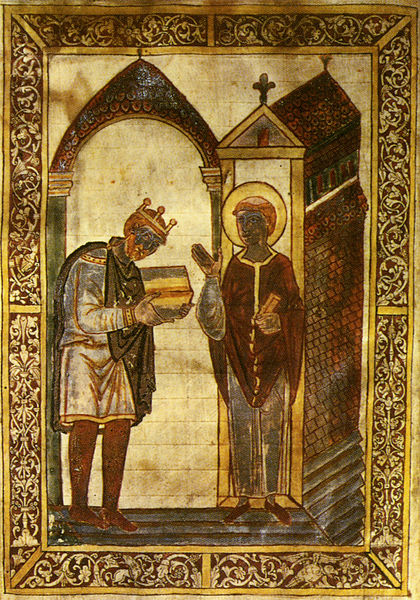
November 19, 2013, by Harry Cocks
The Venerable Bede in European Context
The Venerable Bede (c. 673-735), monk, theologian and the first historian of the English people, lived at the monastery of St Peter and St Paul in Monkwearmouth and Jarrow in Northumbria on Britain’s north-east coast. While an earlier generation of historians tended to see Bede as living at the ragged edge of Christian civilisation, working away at his histories and commentaries in monastic isolation and solitude, recent work by Dr Peter Darby, a medieval historian who has just joined us at Nottingham University, demonstrates Bede’s centrality to a much wider contemporary European culture. (Bede is depicted top right receiving an edition of his Lives of St Cuthbert from King Athelstan of England).
In a new article for the journal Early Medieval Europe based on research from his British Academy Postdoctoral Fellowship, Dr Darby examines Bede’s intervention in a Christendom-wide controversy about the use of images for ecclesiastical decoration, a debate that originated in the Byzantine empire during the reign of Emperor Leo III (714 – 741). In De templo, a commentary on the biblical account of the construction of the Temple of Solomon, (1 Kings 5:6 – 7:51), Bede repeatedly engaged with the theme of the visual arts. This commentary emerged in part from the fact that in Bede’s lifetime the churches at Wearmouth and Jarrow were richly decorated with panel paintings from Rome. Dr Darby examines the significance that those paintings held for Bede and his community, and reveals the strategies he employed to defend them in his commentary on Solomon’s Temple. For example, Bede took special care to celebrate the contribution that artists and craftsmen had made, and continued to make, to the building of the Christian Church.
Bede’s De templo shows that far from being isolated from the key currents of religious debate, monks like him had access to information about the Byzantine image controversy taking place virtually at the other end of the Christian world. This demonstrates that even in the eighth century intellectual networks could spread across the whole of Europe. It also shows Bede’s centrality to the intellectual landscape of early-eighth-century Europe, not to mention the ambition and topical relevance of his mature exegetical programme.
P. N. Darby, ‘Bede, Iconoclasm and the Temple of Solomon’, Early Medieval Europe, 21.4 (2013), 390-421.
http://onlinelibrary.wiley.com/doi/10.1111/emed.12024/abstract

[…] The Venerable Bede (c . 673-735), monk, theologian and the first historian of the English people, lived at the monastery of St Peter and St Paul in Monkwearmouth and Jarrow in Northumbria on Britain's north-east coast. […]